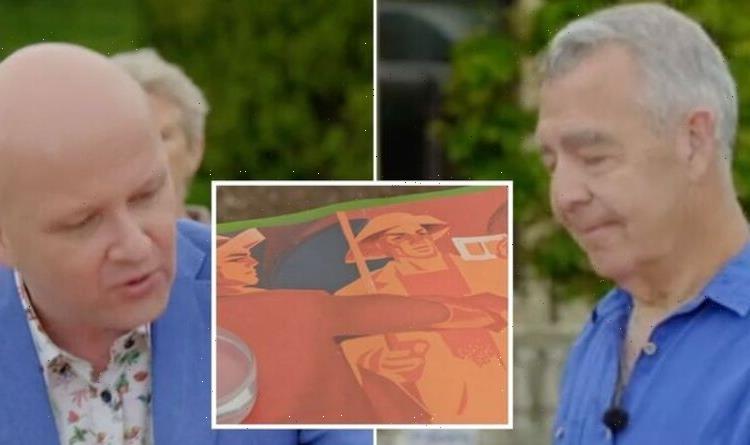Antiques Roadshow: Paintings are worth more than guest wanted
We use your sign-up to provide content in ways you’ve consented to and to improve our understanding of you. This may include adverts from us and 3rd parties based on our understanding. You can unsubscribe at any time. More info
On a recent episode of Antiques Roadshow, Fiona Bruce and her team were at Dyffryn Gardens near Cardiff, where treasures included a necklace made from some of the largest pieces of Baltic amber seen by jewellery specialist John Benjamin. While the BBC host explored the history of Nantgarw porcelain, TV expert Chris Yeo was left in awe after a guest brought in a collection of “propaganda” posters from the Soviet Union dating back to the 1970s.
Upon inspection of the posters, Chris beamed: “It’s bold, it’s colourful, it’s graphic, and it’s a very long way from home.
“What we’re looking at is a propaganda poster from the Soviet Union.”
“[And] what I’d like to know is how do they get from communist Russia to South Wales?” he asked.
The guest responded: “I was a student in Minsk in 1974 and I wanted to impress people when I came back with something to put on my walls… to show how the other half lived.
READ MORE:NCIS fans voice concern after NCIS Sydney announcement

The specialist wondered: “So, can I ask, where were you finding these posters?”
“In a bookshop in Minsk,” the owner continued: “There weren’t that many shops, there was only one shop that sold them.
“So we’d go in every week and see what new posters were in.”
The BBC host quizzed his guest on how much he had paid for his collection of “psychedelic” Russian posters.


The guest revealed: “10 kopecks, which would have been a few pence.”
Chris informed BBC viewers: “Okay. Soviet poster art has a really central place in the history of communist Russia.
“Posters were being used to convey the communist message to get people on side, [to] resell the idea of communism.”
“These wonderful images of strong graphic bold colours, simple slogans that stop you in your tracks and that are what people like about them,” he gushed.
The guest was asked to translate a slogan written in Russian in the corner of the artwork.
“It says: ‘In 1974 Let’s give 135.9 million tonnes of steel ahead of schedule’,” he clarified.
The expert informed viewers: “[It’s] very, very typical, this idea that it’s getting behind in promoting collective effort.”
On the other posters, Chris remarked on the use of figures which had been selected for the cover art, including a nurse, an astronaut, a musician and a railway worker with “high cheekbones and a chiselled jaw”.
When it came to the valuation, Chris told his guest: “So you were paying in 1970 for less than 10 pence for these posters, I think things have moved on since then.”
“These are very, very much what people want at the moment.
“I think for these, we’ve got to be thinking in terms of £40 to £60, perhaps even up to £80 each.”
While it was unknown whether the guest planned to sell his Russian collection, the historian thanked the owner for bringing them on the show.
Antiques Roadshow episodes can now be streamed on BBC iPlayer.
Source: Read Full Article
